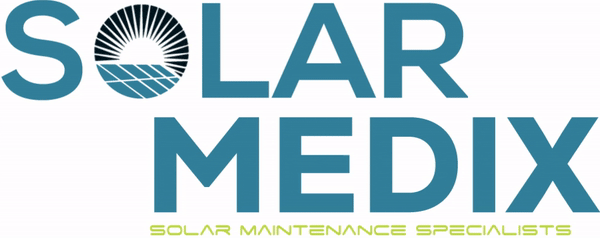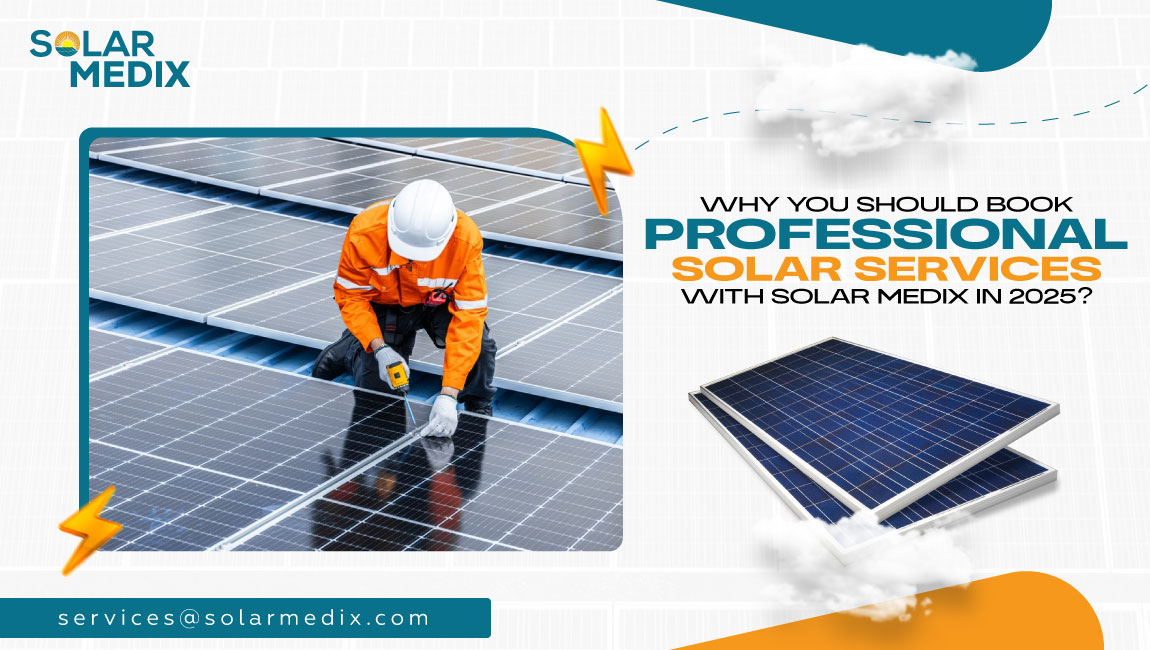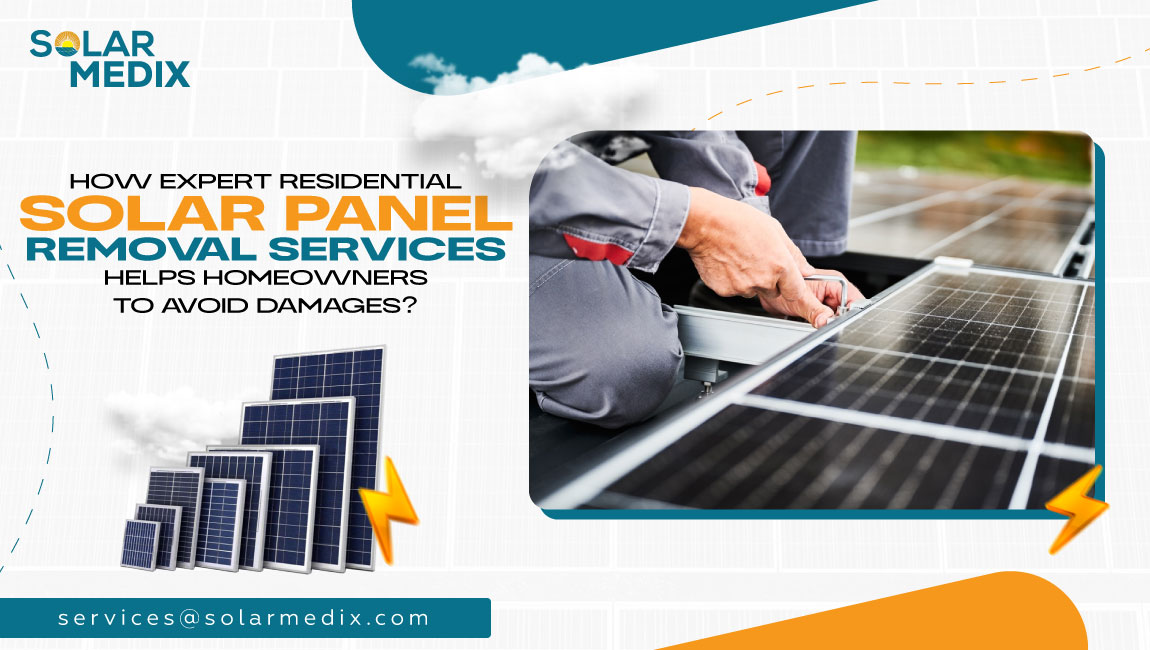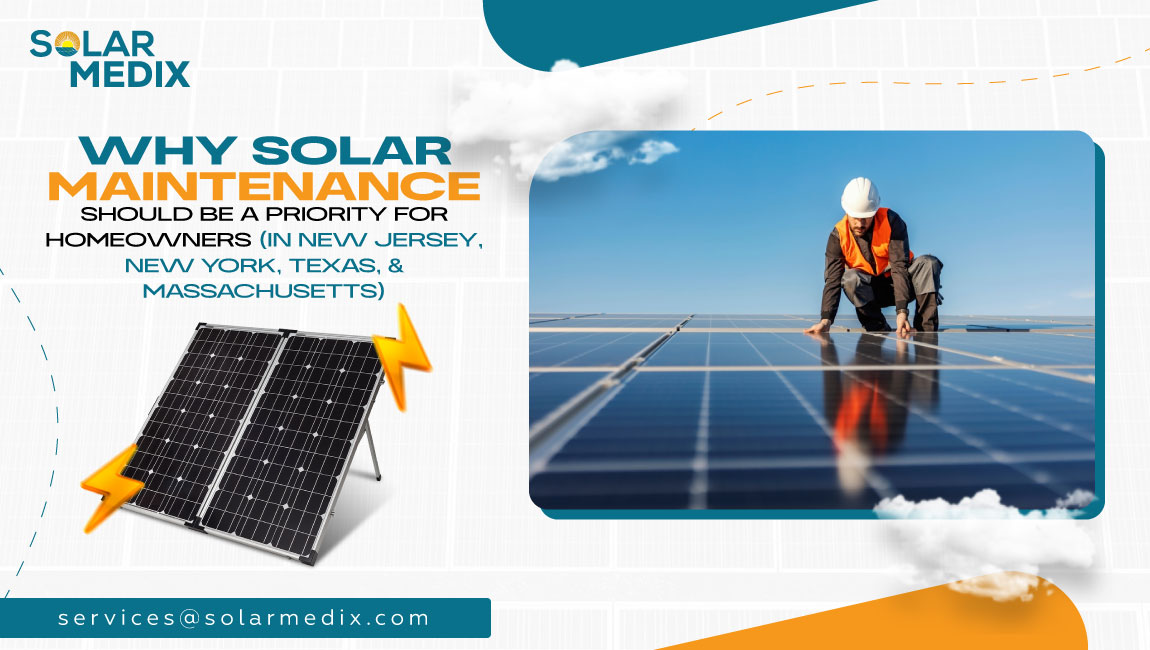Over time, solar energy has become increasingly used because a lot of homeowners are looking out to find ways of reducing their carbon emissions as well as cutting electricity bills.
One of the most common solutions today is community solar, as it gives a means of using solar power without the need for any expensive rooftop installation.
In USA., there has been a noticeable growth of community solar projects in 2024, which is accommodating everyone to go green.
This article will focus on community solar, its advantages and disadvantages, and its differences from dedicated solar installation.
Moreover, we will mention relevant states where you can start to take part in community solar programs this year, helping you to decide whether this new energy source fits your needs and preferences.
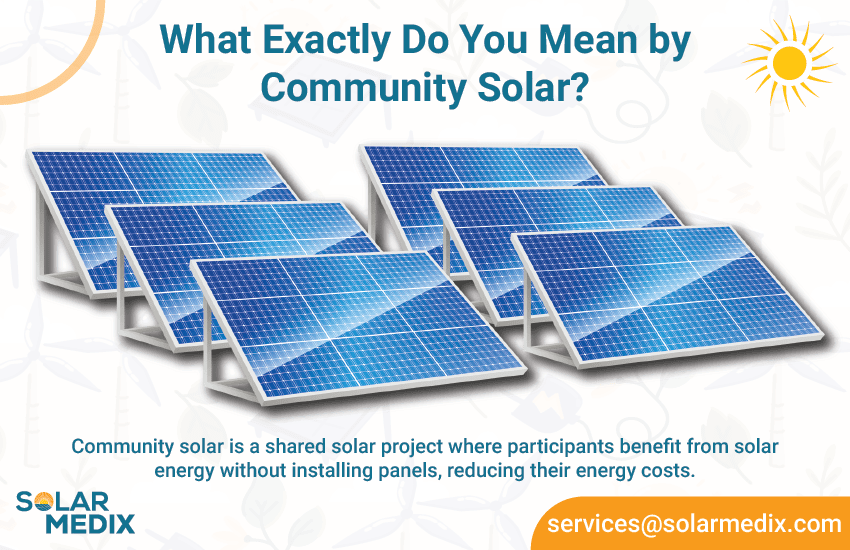
What Exactly Do You Mean by Community Solar?
Community solar refers to a communal approach to solar energy use where different users enjoy the benefits of a solar farm’s energy without installing it on their buildings.
Large-scale solar facilities, also called solar farms or solar gardens, consist of land that has been developed with arrays of solar panels to harness and generate electricity from sunlight.
Users subscribe to a solar farm and get credits in their electricity bills to reflect what they have consumed from the farm-specified energy providers. This allows people who do not have a house with a big roof or are unwilling to pay to install solar panels to benefit from solar energy.
- Community solar helps provide access to solar energy regardless of whether you rent or own a house.
- There are credits awarded to participants that are applied to bills, lessening payments.
- There is no need for subscribers to worry about the upkeep of the panels since the solar farm has that concern.
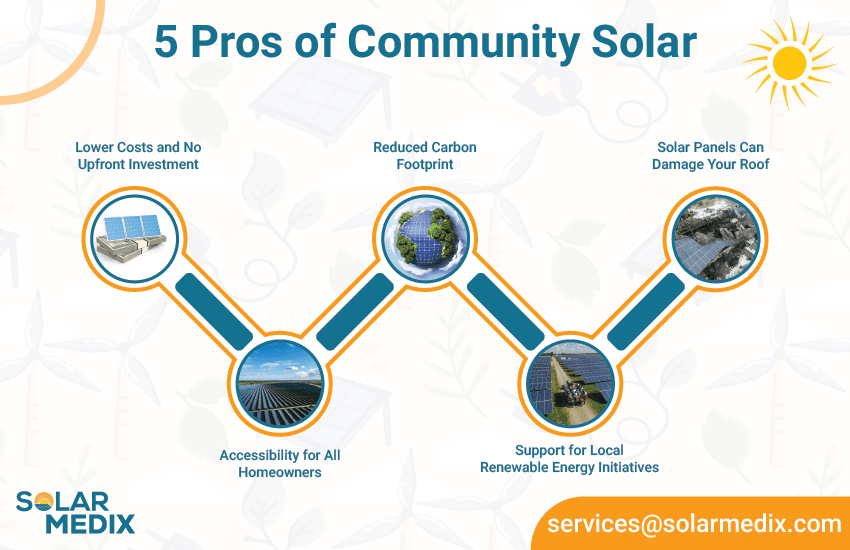
5 Pros or Advantages of Community Solar
- Lower Costs and No Upfront Investment
- Accessibility for All Homeowners
- Reduced Carbon Footprint
- Support for Local Renewable Energy Initiatives
- Solar Panels Can Damage Your Roof
1. Lower Costs and No Upfront Investment
The most important benefit of community solar is that it requires no down payment. This is in contrast to owning solar panels, where the homeowner incurs costs in terms of buying and installing the equipment.
Community Solar is different in that it is based on a subscription model. You pay for the electricity you consume, usually at a cheaper rate than what the electricity service providers charge.
- A pay-as-you-go plan with an anticipated reduction in electricity cost of 10 to 20% is practicable.
- If you are the type who avoids long-term obligations, this is the best option for you.
2. Accessibility for All Homeowners
Due to things like roof structure, shading, or even house ownership, not everybody is able to put up a solar energy system on the roof.
Community solar is a game changer here because it allows the use of renewable sources of energy for more people, such as renters, condo owners, or multifamily unit dwellers.
- Perfect for tenants who do not have the right to attach a solar panel.
- Good for owners of houses with unshaded or appropriate roofing.
- Let every individual play their role in the quest for renewable energy sources.
3. Reduced Carbon Footprint
Community solar enhances the adoption of clean renewable energy and reduces the consumption of fossil fuels, which brings down carbon emissions. By taking part in these programs, you help to forward the cause of clean energy.
- Supports clean energy with no personnel installation
- Decreases greenhouse gasses by replacing electric energy with solar energy.
- Assist cities and states in achieving their renewable energy targets.
- Fact: According to the Solar Energy Industries Association (SEIA), community solar programs in the US have resulted in the elimination of over 10 million metric tons of carbon dioxide emissions every year. It is equivalent to taking more than 2.1 million cars off the road.
4. Support for Local Renewable Energy Initiatives
By signing up to be a part of a community solar advocacy, you are promoting local solar energy projects within the region.
The energy produced will be used in the same electricity distribution system, therefore making the impact of your involvement real and local.
- Motivates the public to take part in renewable energy projects.
- Reinforces the capacity of renewable energy on a local scale.
5. Solar Panels Can Damage Your Roof
In most cases, the insertion of solar panels on roofs may cause some damage, especially among old roofs. There is an opportunity to take up community solar and avoid damaging roofing, the potential of roof leakage, and the burden of regular upkeep.
- Eliminates the need of replacing and repairing roof-mounted solar panels
- No need to invest time and effort in individual solar maintenance.

5 Cons or Disadvantages of Community Solar
- Limited Savings Compared to Owning Panels
- Lack of Control Over Energy Production
- Potential Availability or Subscription Limits
- Long-Term Contracts and Commitments
- Access Is Dependent on Where You Live
1. Limited Savings Compared to Owning Panels
Community solar programs tend to yield some return on investment. However, in the long run, it cannot be expected to outperform owning solar rooftop systems. Once all solar panels are installed in a household, the occupants never have to pay for electricity bills.
- Limited savings on electricity bills, only up to 5-20%.
- Owning panels can offer higher returns over time.
- Long-term savings depend on the subscription model and energy use.
2. Lack of Control Over Energy Production
In community solar, you still don’t typically own the panels, hence, you will not have direct ownership of the energy produced. People who want more control over their energy production and consumption can find it restrictive.
- Energy production is managed by the solar farm, not the individual.
- No ability to increase or decrease energy generation as needed.
- Participants rely on the solar farm for energy distribution and management.
3. Potential Availability or Subscription Limits
Community solar is a trend that is becoming increasingly common, and more people are enrolling in the schemes. But in some areas, not all solar farms will be able to take in more users, as some have a maximum capacity.
- Availability depends on the region and local solar farms.
- Not all states offer community solar programs yet.
4. Long-Term Contracts and Commitments
On the downside, some special cases have long-term commitments, which is a disadvantage to patients who may move or want to cancel their subscriptions. The patient has to make sure that they have read the contract before it is signed.
- Some of these long-term contracts will include some early termination fees.
- Moving may complicate the contract transfer or cancellation process.
- Flexibility in contract terms varies by provider.
5. Access Is Dependent on Where You Live
Community solar programs often require participants to live within a certain distance of the solar farm. This can limit access for individuals in urban areas or regions without available space for solar farms.
- Location restrictions may prevent some from joining a solar farm.
- Urban areas with limited land may struggle to offer community solar projects.
- Participants must reside within a specific radius of the solar farm.
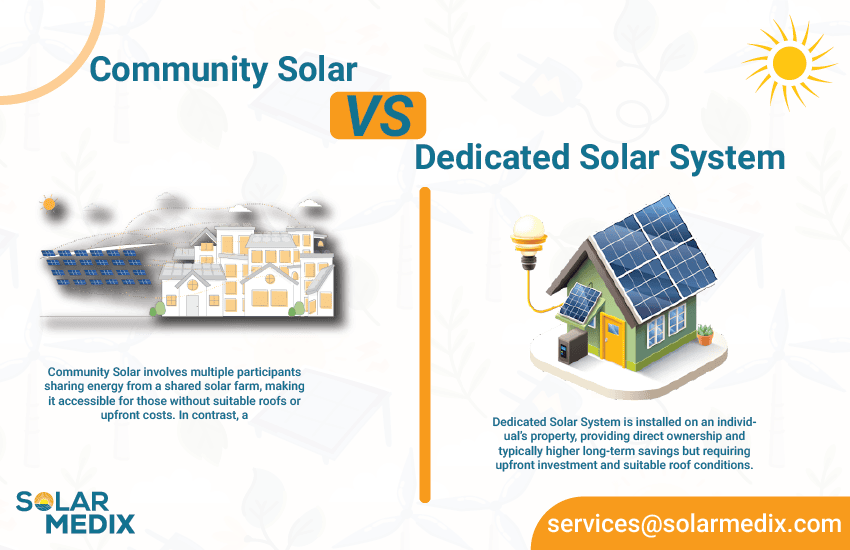
Community Solar vs Dedicated Solar System
| Feature | Community Solar | Dedicated Solar System |
| Upfront Cost | No upfront cost | Requires significant upfront investment |
| Energy Savings | 5-20% savings on electricity bills | Potential to eliminate electricity bills |
| Ownership | No ownership of solar panels | Full ownership of solar system |
| Maintenance | Managed by a solar farm | Homeowner responsible for maintenance |
| Flexibility | Full ownership of the solar system | Full control over energy production |
| Availability | Depends on local availability | Available for any suitable property |
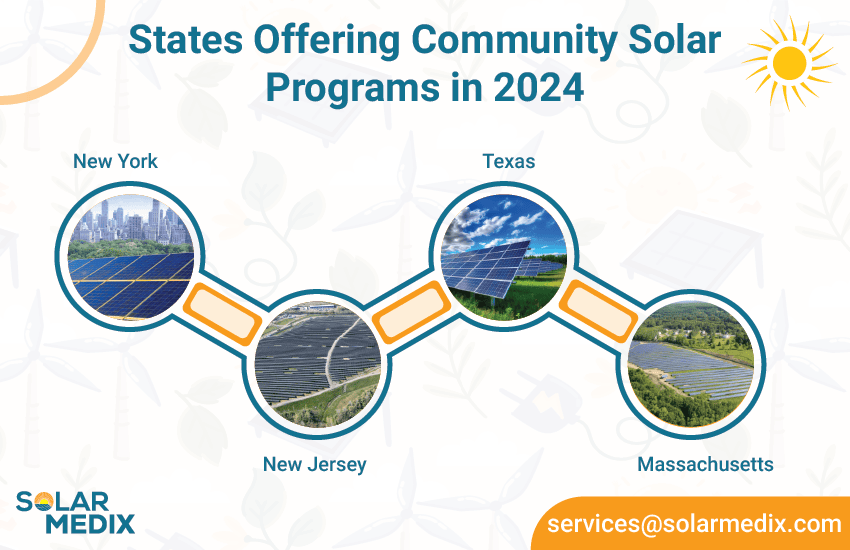
States Offering Community Solar Programs in 2024
Many states are making great strides towards community solar, and 2024 promises residents readily available and affordable solar energy. Don’t know if your state offers community solar? You can check here.
Some of the most active states that offer community solar are:
- New York
- New Jersey
- Texas
- Massachusetts
1. New York Community Solar
- Strong incentives for community solar participants.
- A growing number of solar farms across the state.
2. New Jersey Community Solar
- Offers community solar through its Clean Energy Program
- Community solar is the best suitable option for renters and condo owners to participate in renewable energy programs.
3. Texas Community Solar
- Texas is also rapidly expanding its solar energy initiative and including community solar projects in its program.
- Great option for residents looking to reduce their carbon footprint.
4. Massachusetts Community Solar
- One of the first states to launch community solar programs.
- Extensive solar farms and ongoing support for renewable energy.

Is Community Solar Beneficial for Homeowners and Businesses in 2024?
Community solar has quite a number of benefits especially when it comes to homeowners and businesses — this offers the ability to have access to renewable energy without the hassle of installation or maintenance.
For residents, it means more affordable energy and the ability to help the environment – for businesses, it can mean cost savings and a green reputation. On the other hand, businesses that may need to get more power from community solar might be wary of long-term commitments and their inability to control energy production.
In the end, whether or not joining a community solar program is right for you will simply depend on your individual circumstances. As homeowners are seeking a low-stress way to get into renewable energy, they will find community solar more beneficial in 2024, with increasing availability and more contract options continuing to rise.
- Fact: According to the National Renewable Energy Laboratory (NREL), more than 4.4 GW of community solar was installed in the US in 2023—enough to power approximately 800,000 homes. This figure is expected to increase in 2024 as states continue to scale their community solar programs.

Need Help Deciding on Community Solar? Consult Solar Medix Today!
If you have questions and do not know what to choose, consider consulting with Solar Medix experts about the right community solar model. With our expertise in solar power solutions, we can walk you through each step and will help you understand what you need and which plans are right for your needs.
Get in contact with Solar Medix today to explore if solar energy is right for you.
Frequently Asked Questions (FAQs)
In community solar, individuals subscribe to receive benefits from a centralized solar farm in the form of credits on their electricity bills, based on power generated by the farm.
You can sign up to participate by locating a nearby solar farm, discovering the subscription pricing, and signing up through the provider. There are also community solar programs, which your local utility may provide.
Yes, community solar is a real, legitimate, and emerging form of energy in the renewable sector and provides clean electricity to people all over the U.S.
